
「一汁一菜」をインド料理で組み立てる(ベジタリアン対応可) Assembling a "one soup, one dish" meal with Indian cuisine (Vegetarian options available)
ハーブとスパイスの誘惑 The temptation of herbs and spices
ストーリー
Recipe trivia
食養生という考え方は、世界の食文化に組み込まれている。外科医療や近代的な薬理学が当たり前でなかった時代には、未病であることが寿命を左右したのだ。中国の薬膳然り、インドのアーユルヴェーダ然りである。禅は、インドに端を発し、中国を介して日本に伝わった仏教がルーツになっている。当時の仏教寺院は大学を併設し、単に宗教というだけでなく、総合学府としても機能していた。中国に仏典を持ち帰った玄奘(三蔵法師)もインドの仏教大学に学んでいる。仏教の食に関する考え方にも当然そういった流れを見ることができる。アーユルヴェーダも漢方医学も、現代西洋医学よりも予防医学面を重視する。特にアーユルヴェーダは精神医学の一面を持ち、禅のルーツになったのが、アーユルヴェーダに起源を持つ瞑想法のヨガだ。ヨガがアーユルヴェーダと深く結びついている理由は、精神のバランスが崩れることが病に繋がるからだ。仏教が成立した時代にはアーユルヴェーダの体系が完成し、広く普及していて、宗教の生活戒律や修養とは切っても切れない縁があるのだ。その考え方が、マインドフルネスとして、ストレスの多い現代社会で再び高い評価を受けているのはご存知の通りだ。日本の禅の開祖たちが持ち帰ったのは、宗教だけではなく、高度の精神修養法と未病の生活様式であった。禅の基本的な食事様式である「一汁一菜」にも、当然その流れが組み込まれている。禅の開祖の一人である道元は「典座教訓(てんぞきょうくん)」と「赴粥飯法(ふしゅくはんぽう)」に、その方法論をまとめている。「一汁一菜」は栄養学的な解釈による健康法のプロパガンダとして再解釈されているが、実は「食を入り口として、生命と向き合うための修行一環」という、もっと深い意味を持つのだ。
「一汁一菜」については、以前の記事でも説明しているので、よければ参考にしてください。
The idea of dietary therapy is integrated into food cultures around the world. In times when surgical medicine and modern pharmacology were not commonplace, preventing illness determined one's lifespan. This is true of Chinese medicinal foods and Indian Ayurveda. Zen also has its roots in Buddhism, which originated in India and was transmitted to Japan via China. Buddhist temples at that time had universities attached to them, and functioned not only as religions but also as comprehensive educational institutions. Xuanzang(Sanzang Fashi), who brought Buddhist scriptures back to China, also studied at a Buddhist university in India. Naturally, this trend can be seen in Buddhist thinking about food. Both Ayurveda and Chinese medicine place more emphasis on preventive medicine than modern Western medicine. In particular, Ayurveda has an aspect of psychiatry, and yoga, a meditation method that originated in Ayurveda, is the root of Zen. The reason yoga is deeply connected to Ayurveda is because mental imbalance leads to illness. By the time Buddhism was established, the Ayurvedic system had been perfected and widely spread, and it is inseparably linked to religious discipline and training. As you know, this way of thinking, known as mindfulness, is once again highly regarded in today's stressful society. The founders of Japanese Zen brought back not only religion, but also advanced spiritual training and a lifestyle to prevent illness. Naturally, this flow is also incorporated into the basic Zen meal style of "one soup and one dish." Dogen, one of the founders of Zen, summarized the methodology in "Tenzo Kyokun" and "Fushuku Hanpo." "One soup and one dish" has been reinterpreted as a propaganda for a health method based on a nutritional interpretation, but in fact it has a deeper meaning as "a part of the training to face life with food as an entry point."
I have explained the concept of "ichiju-ichisai(one soup and one dish)" in a previous article, so please refer to that if you are interested.
最近は、インド料理が広く日本でも紹介されるようになったので、だいぶ認識が変わってきたと思うが、日本で食べられるカレーは、インドの庶民が普通に食べている家庭料理とはかなり違う。日本の家庭と同じで、向こうの家庭では、漬物があって煮物や焼き物揚げ物があって、スープがあって、パンやライスが添えられる。ここ10年ぐらい日本でも急に認知度が上がってきた南インドの「ミールス(meals)」が、その例だ。多文化国家のインドには、ミールス以外にも、そんな家庭料理が山ほどある。ご飯と肉のカレーをメインに具材をトッピングして食べるというのは、点心の一つであったラーメンをワンディッシュ化した「日本式ラーメン」と同じ、日本式ファーストフードの発想だ。電気がなく、ガス器具のなかった時代には、家庭の設備も限られていた。残火で保温しておけるスープ料理は庶民の食卓にふさわしい。温かいスープに、パンやお米を添えて、常備菜として作っておいた煮物や漬物を添えて食べる。まさに「一汁一菜」の献立になる。無理矢理型に嵌めずとも、ケの日の質素な家庭料理の構成はどこの国でも自然と「一汁一菜」に辿り着く。もちろんハレの日や余裕があれば、品数が増えていく。日本の「一汁三菜」とか「ニ汁五菜」と同じだ。こういった質素な庶民の食事を、禅の修行僧の日々の修養法として取り入れ、規定したのが、前述した道元の経典だ。一つは作り手の作法と心構えについて、もう一つが食べ手の作法と心構えについて説かれたものだ。どこの文化圏の料理であれ、古くからの食文化を持つ庶民の料理には「一汁一菜」のアイデアがいっぱい詰まっているのだ。
Recently, Indian cuisine has been widely introduced in Japan, so I think the perception has changed a lot, but the curry eaten in Japan is quite different from the home cooking that ordinary Indians usually eat. Just like in Japanese homes, Indian homes have pickles, stewed, grilled, and fried foods, soup, and bread and rice. One example is the South Indian "meals," which have suddenly become more well-known in Japan in the last 10 years. In India, a multicultural country, there are a ton of such home cooking other than meals. Eating rice and meat curry as the main dish with toppings is the same Japanese fast food idea as "Japanese-style ramen," which is a one-dish version of ramen, which was a type of dim sum. In the days before electricity and gas appliances, household facilities were limited. Soup dishes that can be kept warm by embers are suitable for the dining tables of ordinary people. Warm soup is served with bread and rice, and stews and pickles that have been prepared as staple dishes. It's exactly a menu of "one soup and one dish." Even without forcing it into a mold, the composition of simple home cooking on a day like this will naturally result in "one soup and one dish" in any country. Of course, on special days or if there is more money, the number of dishes will increase. It's the same as Japan's "one soup and three dishes" or "two soups and five dishes." The aforementioned Dogen sutra is what adopted and prescribed this simple meal of the common people as a daily training method for Zen monks. One of them explains the manners and mental attitude of the cook, and the other explains the manners and mental attitude of the eater. Regardless of the cuisine of any culture, the cuisine of the common people with its ancient food culture is full of ideas for "one soup and one dish."
だから、インドの家庭料理で「一汁一菜」を構成するのは、とても意味のある試みだと思っている。「地中海風一汁一菜」とか「アステカ風一汁一菜」なんていうのも面白そうだ。その辺りはまた次の機会に。
ここで作ってみたのは「朝ごはんとしての一汁一菜」なので、日本のレストランにあるようなファーストフードカレーやインドレストランで出るスパイスカレーではなく、南インド風の穏やかな味付けの家庭料理で組み立てる「一汁一菜」。
構成は、「ターメリックライス」と「アチャール(インド風ピクルス)」、「一汁」は「サンバール(インド風野菜と豆のスープ)」、「一菜」は「チキンキーマ」。チキンキーマは、鶏を豆由来の食材や茸に変えれば、ベジタリアン対応が可能。
That's why I think that making "one soup and one dish" with Indian home cooking is a very meaningful attempt. It would also be interesting to make something like "Mediterranean-style one soup and one dish" or "Aztec-style one soup and one dish." I'll talk about that another time.
What I made here is "one soup and one dish for breakfast," so it's not the kind of fast food curry you'd find in Japanese restaurants or the spicy curry you'd get in Indian restaurants, but rather a "one soup and one dish" made up of mildly seasoned southern Indian-style home cooking.
The meal consists of turmeric rice, achar (Indian pickle), soup sambar (Indian vegetable and bean soup), and side dish chicken keema. Chicken keema can be made suitable for vegetarians by replacing the chicken with bean-based ingredients or mushrooms.
Ingredients:
材料:
米(普通の日本の米で良い。インドの短粒種が手に入るならなお可)
鶏胸肉
じゃがいも
玉葱(ここではレッドオニオンを使っているが、普通の玉葱で良い)
レンズ豆(マスールダル。他の種類のダルでも良い)
プランターから収穫したミニトマト(市販の普通のトマトや水煮トマトでも良い)
プランターから収穫したナス※1
プランターから溢れた未成熟ミニトマト※1
ココナツミルク(ココナッツパウダーでも良い)
レモン
カレーリーフ(ここでは乾燥のものを使っているが、手に入るなら生葉の方が良い。月桂樹で代用しても良い)※2
シナモンスティック※2
グリーンカルダモン※2
クローブホール※2
フェネグリーク※2
クミンシード※2
マスタードシード※2
唐辛子※3
タマリンドペースト※4
生姜
にんにく
パプリカパウダー
カイエンヌペッパー
ターメリックパウダー
ガラムマサラ※5
ココナッツオイル(酸化しにくい油ならなんでも良い)
胡麻油
自然塩
※1 ここでは、たまたま収穫したナスと未成熟のミニトマトを使ったが、ズッキーニ、苦瓜、インゲンなど、好きな夏野菜を使うと良い。
※2 ここではホールスパイスを使っているけど、パウダーでも良いし、面倒ならマイルドなブレンドのカレー粉を使っても良い。パウダーを使う時は、香りを殺さないよう、仕上げのタイミングで加えると良い。
※3 唐辛子は生のものを使っているが、カイエンヌペッパーを多めに入れて代用しても良い。
※4 タマリンドペーストは、梅干しと砂糖を練ったものや、梅ジャム、杏ジャムなどで代用しても良い。
※5 ガラムマサラは、メーカーによってかなり味が違うので、好みのものを使うと良い。余裕があるなら、自分で調合しても良い。
Rice (regular Japanese rice is fine. If you can get Indian short grain rice, that's even better)
Chicken breast
Potatoes
Onions (red onions are used here, but regular onions are fine)
Lentils (masoor dal. Other types of dal are fine too)
Cherry tomatoes harvested from a planter (regular tomatoes sold in stores or canned tomatoes are fine)
Eggplant harvested from a planter*1
Unripe cherry tomatoes overflowing from a planter*1
Coconut milk (coconut powder is fine too)
Lemon
Curry leaves (dried ones are used here, but fresh leaves are better if you can get them. You can also substitute with bay leaves)*2
Cinnamon sticks*2
Green cardamom*2
Whole cloves*2
Fenugreek※2
Cumin seeds*2
Mustard seeds*2
Chili peppers*2
Tamarind paste*4
Ginger
Garlic
Paprika powder
Cayenne pepper
Turmeric powder
Garam masala※5
Coconut oil (any oil that doesn't oxidize easily is fine)
Sesami oil
Natural salt
*1 Here, I used eggplant and unripe cherry tomatoes that I happened to harvest, but you can use your favorite summer vegetables such as zucchini, bitter melon, or green beans.
*2 I used whole spices here, but you can also use powder, or if you don't want to bother, you can use a mild curry powder blend. If you use powder, it's best to add it at the end to avoid killing the aroma.
*3 I used fresh chili peppers, but you can also substitute with a lot of cayenne pepper.
*4 The tamarind paste can be substituted with pickled plums and sugar, plum jam, or apricot jam.
*5 The taste of garam masala varies greatly depending on the manufacturer, so use your favorite one. If you have the time, you can also mix it yourself.
procedure:
手順:
(アチャールの準備)
未成熟のミニトマトを洗って半分に切る。茄子は、適当なサイズに切り分ける。
生姜を千切りにする。
唐辛子の種を除く(辛いのが大丈夫なら、そのままで良い)
(Preparing the achar)
Wash the unripe cherry tomatoes and cut them in half. Cut the eggplant into bite-sized pieces.
Slice the ginger into thin strips.
Remove the seeds from the chilli pepper (if you like it spicy, you can leave it whole).

(アチャールを作る)
鍋にココナッツオイルを入れ、フェネグリーク、マスタードシード、生姜、唐辛子を入れ、マスタードシードが弾けて香りが出るまで、熱する。
そこに、下拵えをした野菜を入れ、塩を加えて全体をかき混ぜて、蓋をし、ナスが柔らかくなるまで、蒸し煮にする。
ナスが柔らかくなったら、カレーリーフリーフを入れ、よく炒める。カレーリーフの香りが立ってきたら、胡麻油、ターメリックパウダーとパプリカパウダーを入れ、レモン汁を絞って、よく混ぜて仕上げる。味を見て、塩加減を調整する。
アチャールは、常備菜として、前日に作っておいた方が、味が染み込んで、美味しい。
(Making achar)
Put coconut oil in a pot, add fenugreek, mustard seeds, ginger and chili pepper, and heat until the mustard seeds pop and release their aroma.
Add the prepared vegetables, add salt, stir everything together, cover and simmer until the eggplant is soft.
When the eggplant is soft, add curry leaves and stir-fry well. When the curry leaves start to become fragrant, add sesame oil, turmeric powder and paprika powder, squeeze in lemon juice, mix well and finish. Taste and adjust saltiness.
Achar is a delicious dish to have on hand, so it tastes better if you make it the day before so the flavors can soak in.





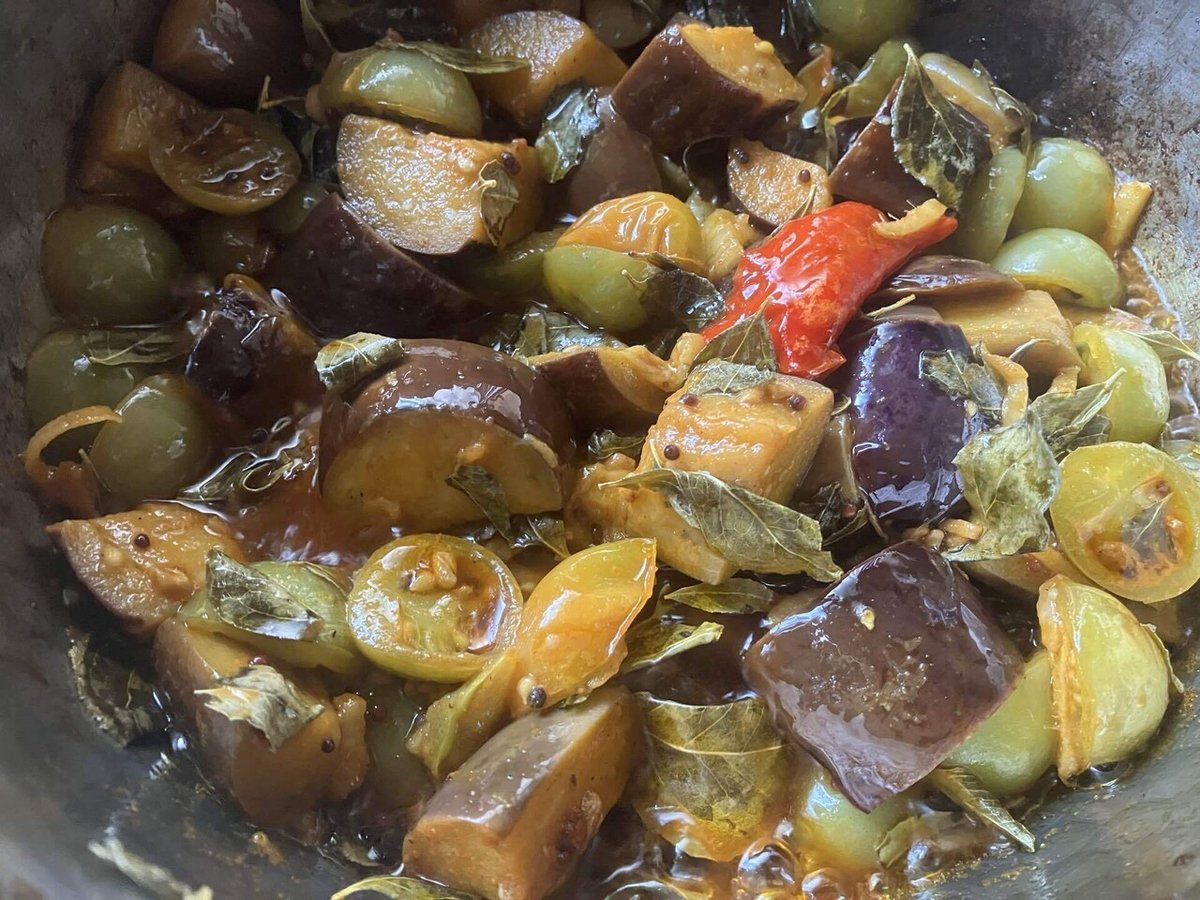
(ターメリックライスの準備)
米を洗い、水加減をして、ターメリックパウダー、塩、ココナッツオイル入れ、吸水させておく。
(Preparing turmeric rice)
Wash the rice, add water, turmeric powder, salt and coconut oil, and leave to absorb the water.

(チキンキーマの準備)
ミニトマトは、半分に切っておく。玉葱と生姜はみじん切りにしておく。にんにくは皮を剥いておく。
唐辛子は、種を除いておく。辛いのが大丈夫なら、種は取らないでも良い。
シナモンスティックは適当に折っておく。カルダモンは皮に包丁で切れ込みを入れておく。
鶏肉は皮を取り、フードプロセッサーで粗めのミンチにしておく。皮は茹でて、一緒にミンチにする。包丁で叩いて、細かくしても良い。
(Preparing the Chicken Keema)
Cut the cherry tomatoes in half. Finely chop the onion and ginger. Peel the garlic.
Remove the seeds from the chili pepper. If you don't mind the heat, you don't need to remove the seeds.
Break the cinnamon stick into chunks. Make slits in the skin of the cardamom with a knife.
Remove the skin from the chicken and coarsely mince it in a food processor. Boil the skin and mince it together with the chicken. You can also pound it with a knife to finely chop it.

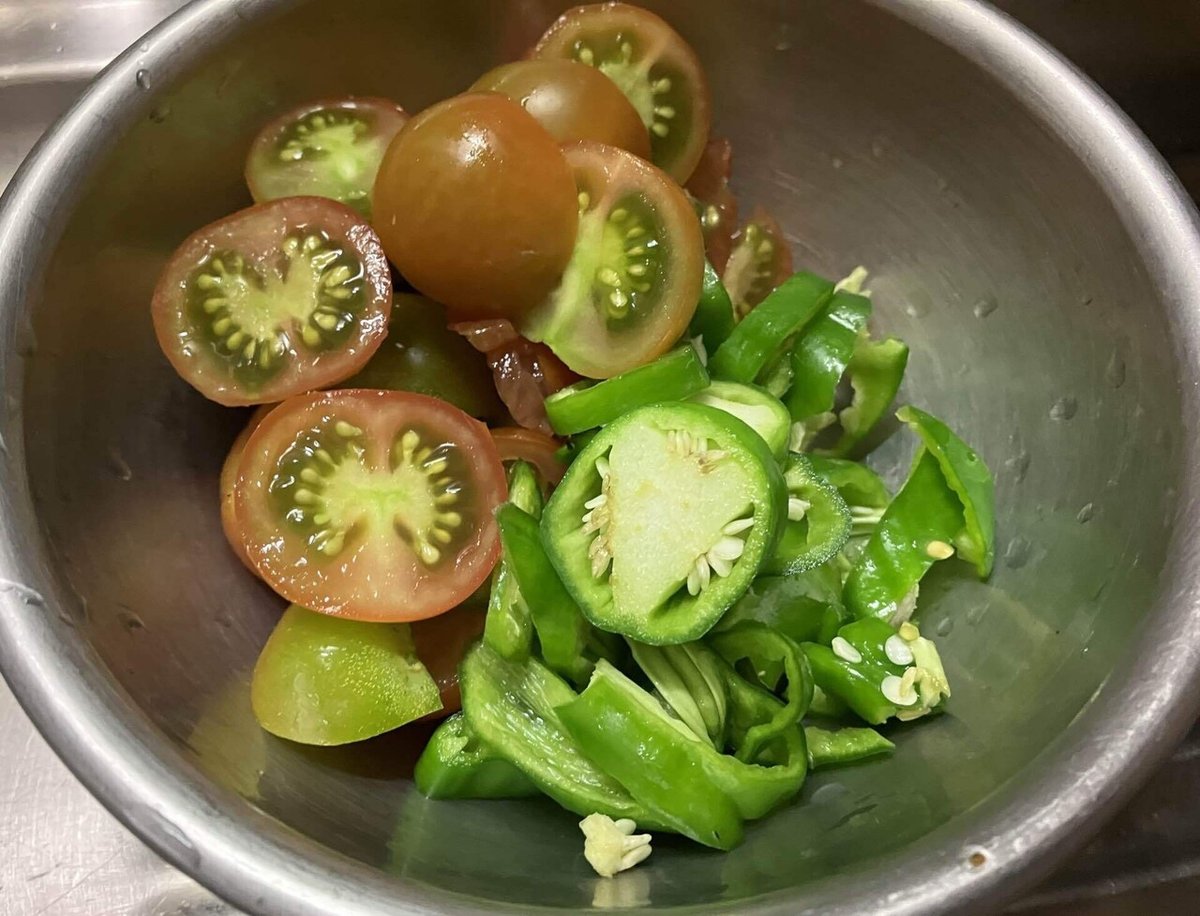

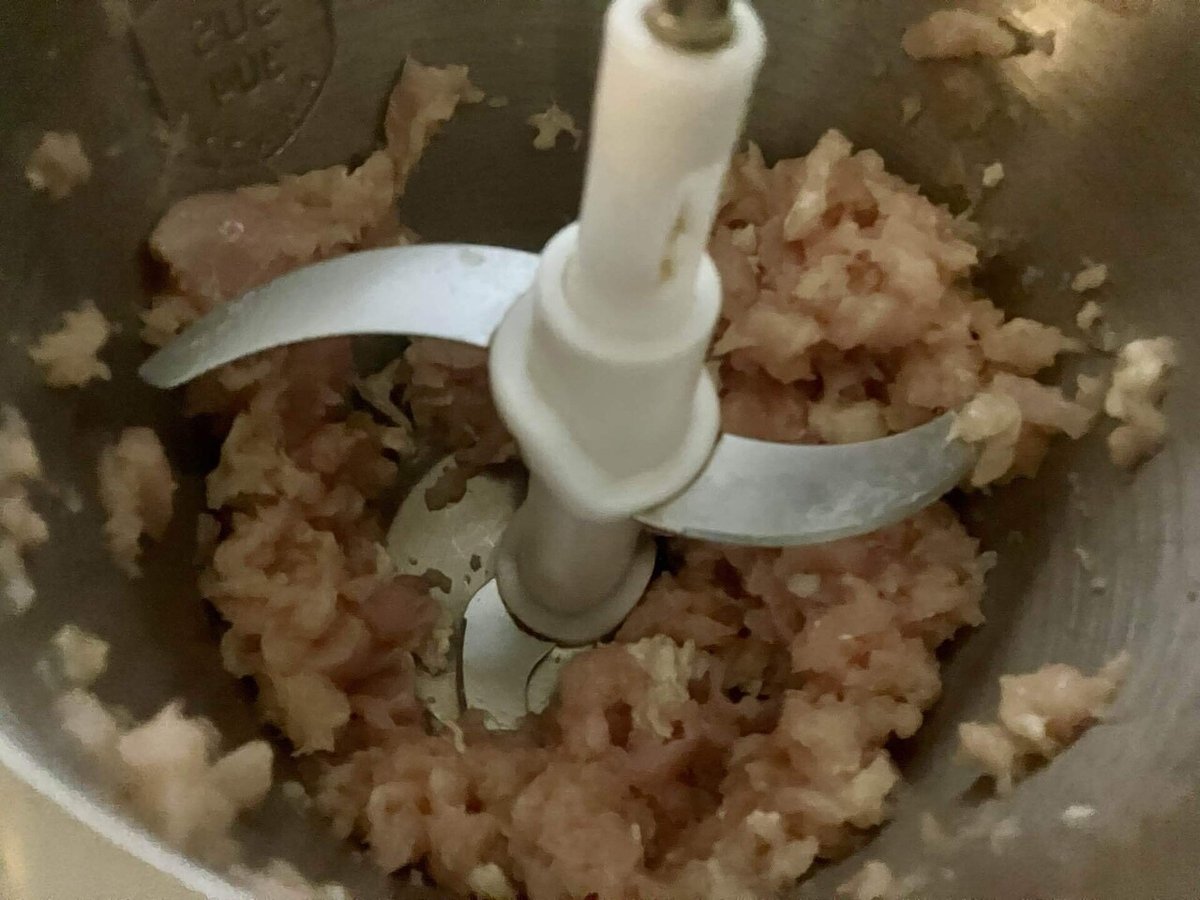

(サンバールの準備)
じゃがいもはサイコロに切り分ける(新じゃがなので、皮は剥かずに使っている)。
玉葱はみじん切りにしておく。
(Preparing the sambar)
Dice the potatoes (I use new potatoes without peeling them).
Finely chop the onion.
(チキンキーマを作る)
厚手の鍋に、ココナッツオイルを入れ、シナモンスティック、カルダモン、クローブ、生姜をいれる。ニンニクも叩き潰して入れる。
スパイスの香りが立ってくるまで炒める。
そこに、玉葱を加えて、中火にし、蓋をして、時々かき混ぜながら、玉ねぎが茶色く色づくまで炒める。
トマトを加えて、トマトの水分が飛んでドロッとするまで、蓋をせずに炒める。
そこに、鶏のひき肉を加えて炒め、カレーリーフ、ターメリックパウダー、パプリカパウダー、カイエンヌペッパーを加えて、さらに炒める。
そこに、水と塩を加えて、15分ほど、濃度がつくまで煮込む。
ココナッツミルクを加えて、さらに5分ほど煮込み、味を見て、物足りないようなら、ガラムマサラと塩を加えて、仕上げる。
(Making chicken keema)
Put coconut oil into a thick-bottomed pot and add the cinnamon stick, cardamom, cloves and ginger. Smash the garlic and add it.
Stir-fry until the spices are fragrant.
Add the onion, turn the heat to medium, cover and stir-fry, stirring occasionally, until the onion starts to brown.
Add the tomatoes and stir-fry, uncovered, until the moisture has evaporated and the mixture becomes thick.
Add the ground chicken and stir-fry, then add the curry leaves, turmeric powder, paprika powder and cayenne pepper and stir-fry some more.
Add water and salt and simmer for about 15 minutes until the mixture thickens.
Add the coconut milk and simmer for a further 5 minutes, taste it and if it's not flavorful enough, add garam masala and salt to finish.




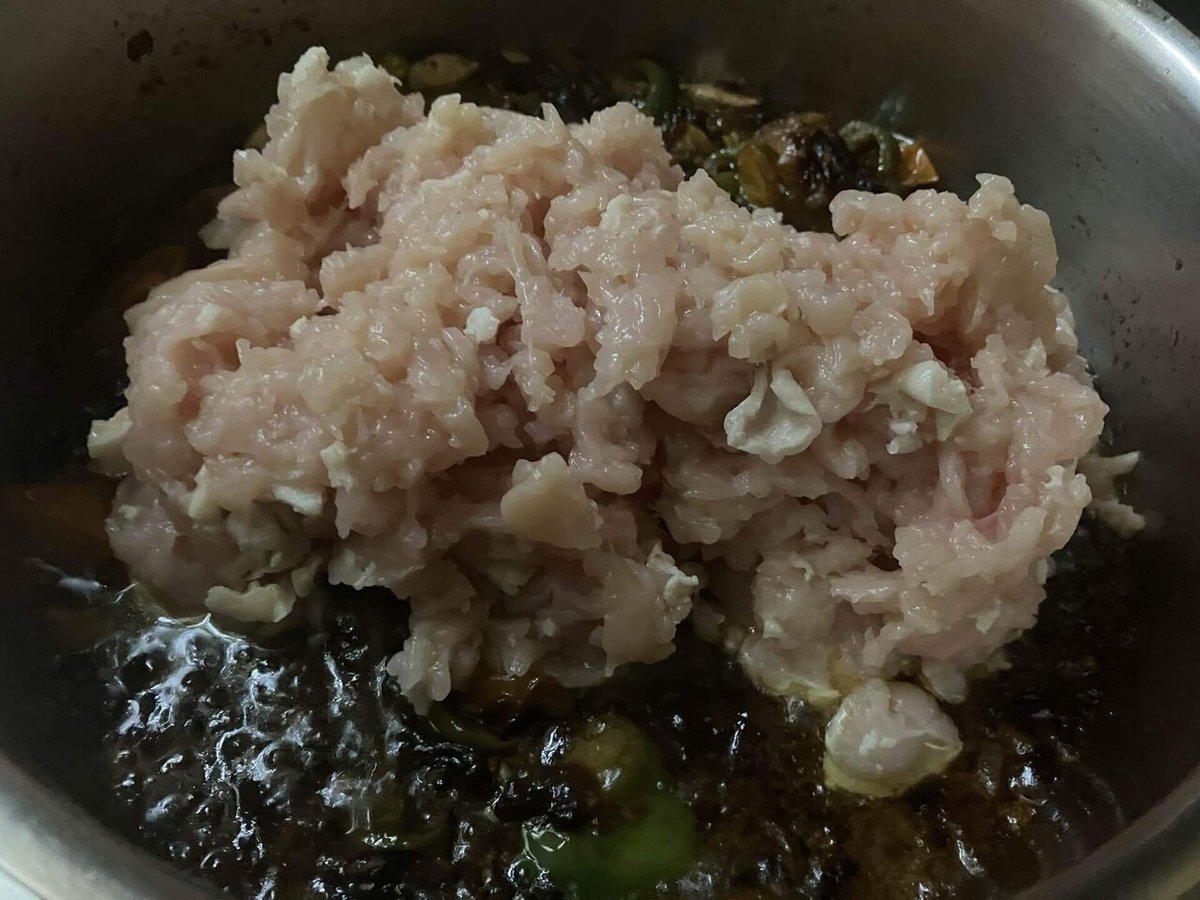

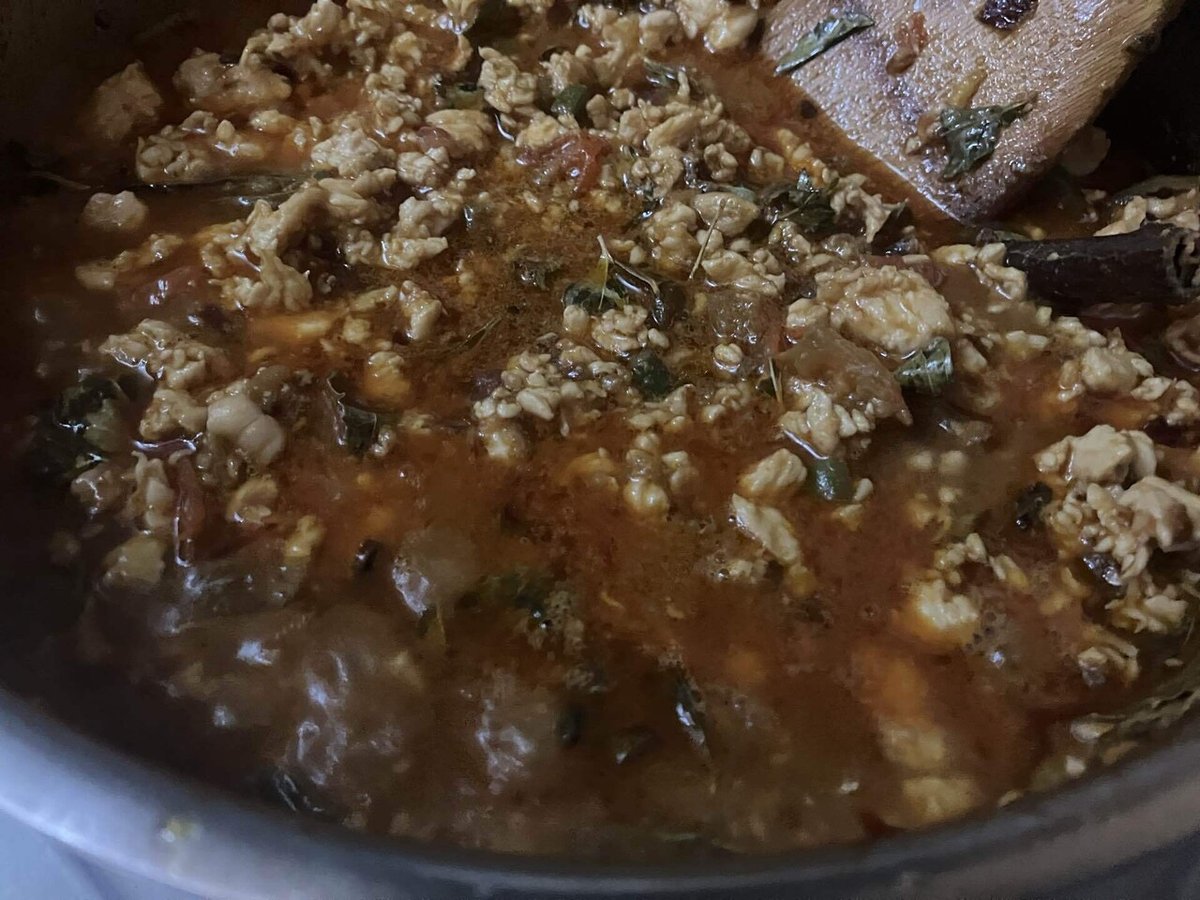

(ターメリックライスを作る)
吸水しておいた米を強火にかけ、沸騰したら、弱火で15分加熱して、10分蒸らす。炊飯器や電子レンジで炊いても良い。
(Making turmeric rice)
Put the soaked rice on high heat, bring it to a boil, then reduce heat to low and cook for 15 minutes, turn off the heat, and let it steam for 10 minutes. You can also cook it in a rice cooker or microwave.

(サンバールを作る)
鍋にココナッツオイルを入れ、クミンシードと唐辛子を入れて、クミンシードが弾けて香りが立つまで炒める。
そこに、じゃがいもと玉葱を入れて炒める。完全に火が通っていなくても、玉葱がしんなりすれば良い。
そこに水を注ぎ、レンズ豆も入れて、レンズ豆とじゃがいもが柔らかくなるまで煮込む。
フライパンなどにココナッツオイルを入れ、マスタードシードを入れて、加熱する。マスタードシードが弾けて香りが出たら、スープに加える。スープの味を塩とタマリンドペーストで整える。
(Making sambar)
Put coconut oil in a pan, add cumin seeds and chili peppers, and fry until the cumin seeds pop and become fragrant.
Add potatoes and onions and fry. It doesn't have to be completely cooked, as long as the onions are soft.
Pour in water, add lentils, and simmer until the lentils and potatoes are soft.
Put coconut oil in a frying pan or similar, add mustard seeds, and heat. When the mustard seeds have popped and are fragrant, add them to the soup. Season the soup with salt and tamarind paste.







四つの料理を盛り合わせる。
Plate and serve the four dishes.

※火口が一つを前提に手順を記してあります。
*The procedure is written assuming there is one burner.
Tips and tricks:
コツと応用のヒント:
全体的に、日本に多い北インド風の香辛料でなく、カレーリーフ、マスタードシード、タマリンド、ココナッツミルクなどを使って、南インド風の味付けに近づけてある。脂っこくスパイシーな北インドのレストラン料理より、朝ごはんには、こちらの方がふさわしいと考えた。この4品に、ラッサム、ボリヤル、ヨーグルト足して、パパドやドーサも添えれば、ニ汁五菜の豪華なミールスに発展させることもできる。
それぞれの料理の、野菜や味付けが被らないようにしたので、日本に紹介されているレシピとは少し違っているかもしれない。例えば、サンバールはトマトを入れるレシピが多いが、トマト味はチキンキーマと被るので、さっぱりタマリンドのみの酸味で仕上げている。
たまたま、大雨で、赤くなる前に、結構なミニトマトが落ちてしまったので、アチャールに使った。ナスも大収穫だったので、そこに合わせた。このアチャールの味付けは、結構夏野菜に合うので、手に入った夏野菜で、インド風ラタトゥイユとして常備しておくと、パンなどの付け合わせに使えて便利。
チキンキーマは、粗挽きの方が美味しいので、自分でミンチにしたが、もちろんひき肉を使っても構わない。皮ももったいないので、茹でてミンチに混ぜている。ここだけが動物性なので、豆や茸にに変えれば、ベジタリアン向けの「一汁一菜」になる。
本当は、カレーリーフは生を使うと、香りが良くて感激するのだけど、日本では生葉は高価で貧乏人の食卓には似合わないので、あえて乾燥のものを使った。東南アジアや南アジアでは生垣になっているようなハーブなので、手に入る人は、断然生葉がおすすめ。最近は苗木が日本に持ち込まれ、国内で栽培している農家もある。
普通のスパイスカレーにはあまりマスタードシードは使わないが、たくさん買っても、自家製のディジョン風のマスタード作りにも使えるので、買っても損はないと思う。
インド料理では、チキンキーマをのように、玉葱をじっくり炒める工程が特徴なので、ステンレス多層の無水鍋があると便利。この鍋でご飯を炊いたり、ラタトゥイユなどを作ると、仕上がりが全然違ってくる。僕は二十代でビタクラフトを買ったが、今でもまだピカピカで現役。アルミ鍋のように、トマトなどの酸でアルミが溶け出すこともなく、安心して使える。
「一汁一菜」からは少し外れるが、ここにヨーグルトを添えると、より完成度が上がる。
これは、ほんの一例で、ベンガルやケララ、スリランカで盛んな魚料理を取り込めば、もっと日本人好みの組み合わせも可能だ。ミールスが流行ると、ミールスはこうでなくちゃ、みたいな型にハマる人が出てくるのだけど、そこはもっと自由で良いと思う。インド人も、外の世界から受容した食材を取り込んで、おかず(菜)のバリエーションを増やしている。家庭でやるなら、インドの食文化の根幹に敬意を示しながらも、いろいろ試してみるのが正解だと思う。高価な材料を取り寄せて現地をそっくり再現するのは、南インドマニアや専門店に任せて、家庭料理としてのインド料理を一汁一菜から体験してみてはどうだろうか?
Overall, I used curry leaves, mustard seeds, tamarind, coconut milk, etc., rather than the North Indian spices that are common in Japan, to make it closer to South Indian seasoning. I thought this would be more suitable for breakfast than the greasy and spicy North Indian restaurant food. If you add rasam, boriyal, and yogurt to these four dishes, and serve papad or dosa, you can develop it into a luxurious meal with two soups and five side dishes.
I tried not to overlap the vegetables and seasonings of each dish, so the recipes may be a little different from those introduced in Japan. For example, many recipes for sambar include tomatoes, but the tomato flavor overlaps with chicken keema, so I finished it off with a refreshing acidity of tamarind only.
By chance, there was a heavy rain and quite a few cherry tomatoes fell before they turned red, so I used them in the achar. There was also a large harvest of eggplants, so I combined them with them. The seasoning of this achar goes well with summer vegetables, so if you keep it on hand as an Indian-style ratatouille using any summer vegetables you have on hand, it's convenient to use as a side dish for bread and other dishes.
Coarsely ground chicken keema tastes better, so I minced it myself, but of course you can use ground meat. I don't want to waste the skin, so I boil it and mix it into the mince. This is the only animal-based part, so if you replace it with beans or mushrooms, it becomes a vegetarian "one soup, one dish" dish.
Actually, curry leaves are more fragrant and more impressive when used fresh, but fresh leaves are expensive in Japan and don't look good on poor people's tables, so I deliberately used dried ones. It is an herb that grows as a hedge in Southeast Asia and South Asia, so if you can get it, I definitely recommend fresh leaves. Recently, seedlings have been brought to Japan, and some farmers grow it domestically.
Mustard seeds are not often used in regular spice curry, but even if you buy a lot, you can use it to make homemade Dijon-style mustard, so I think it's worth buying.
Indian cuisine is characterized by the process of slowly frying onions, like chicken keema, so it is convenient to have a stainless steel multi-layered waterless pot. When you cook rice or make ratatouille in this pot, the end result is completely different. I bought a Vitacraft pot in my twenties, and it's still shiny and in good condition. Unlike aluminum pots, the aluminum doesn't dissolve in the acid from tomatoes and other foods, so you can use it with confidence.
Although it deviates slightly from the "ichiju-ichisai" (one soup, one dish), adding yogurt here makes it even more complete.
This is just one example, and by incorporating fish dishes that are popular in Bengal, Kerala, and Sri Lanka, it is possible to create a combination that is more to Japanese tastes. When meals become popular, some people tend to get stuck in a mold that meals should be like this, but I think it's good to be more free in that area. Indians are also incorporating ingredients from the outside world to increase the variety of side dishes (vegetables). If you're making it at home, I think it's right to try out various things while showing respect for the foundations of Indian food culture. Leave it to South India enthusiasts and specialist restaurants to order expensive ingredients and recreate the local cuisine exactly, and why not try experiencing Indian cuisine as a home-cooked meal, starting with one soup and one dish?
Guide to where to get ingredients and equipment 材料と機材の入手先ガイド
※Amazonのアフェリエイトに参加しています。もしご購入の際はここからクリックしてご購入いただけると、コーヒー代の足しになるので、嬉しいです。ちなみに僕はコーヒー依存症です。
*I participate in Amazon affiliate programs. If you purchase this product by clicking here, it will help pay for my coffee, so I would be very happy. By the way, I am addicted to coffee.
この記事が気に入ったらサポートをしてみませんか?
